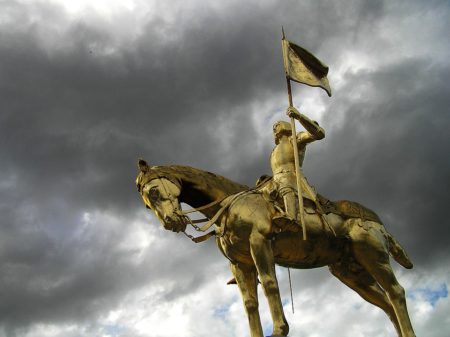Some musings from Mary T. Malone’s book,
“The Elephant in the Church”

Mary T. Malone is the former chair of the University of Waterloo’s Graduate Department of Religious Studies. She returned home to Ireland after 40 years in Canada where she taught in Toronto’s St. Augustine Seminary and in St. Jerome’s Catholic College.
Mary maintains that women are the elephant in the Church, that the female interpretation of Christianity has been suppressed for centuries, resulting in a badly abbreviated understanding of the faith. Women have been perpetually silenced, ignored and discounted by the church.
The silencing of women was initiated by St. Paul around 55/CE believing that women were created second and sinned first. This mantra has continued down through the centuries and has resulted in a male patriarchal Church. Mary’s book explores this story from biblical times to the present day.
If the Christian Church is to survive it must be more inclusive where the gifts of men and women are equally recognised. It is obvious to all that our all male Church is in deep trouble. An unrelenting male language pervades all aspects of the Church – from history to spirituality, from liturgy to theology.
Mary looks firstly at Scripture. It is possible to trace the presence and contribution of women in the early days of Christianity. In the New Testament women are established as apostles, disciples and the only witnesses of the foundational events of Christianity.
Mary examines the Book of Genesis and finds that women are part of the same human family equally created in the image of God. She looks at the philosophy of Aristotle who taught that men were the natural humans, women were a mistake.
St. Augustine’s teaching on sexual differentiation still lies at the root of such teachings as the ban on the ordination of women and clerical celibacy.
Jesus met women as equals. While he does not name women as apostles we know that the very process of writing the gospels deliberately excluded all traces of the leadership roles of women. Women were air brushed out of the picture.
In the 4th century we see the rise of monasticism and the next stage of history of women in Christianity. The two areas where women shone were martyrdom and virginity. The development of total sexual renunciation is an astonishing phenomenon lauded by St. Augustine. The ascetic life became popular. Convents and Monasteries grew up everywhere. Women’s lives became bounded by rules and regulations influenced by St. Augustine, St. Jerome and St. Ambrose. Women were to be silent and submissive. Their model was Our Lady the Virgin.

St. Joan of Arc
The extraordinary influence of the mystics in 1150 – 1450, many of whom were silenced and their writings burned, gives sufficient information for us to see their contribution as brilliant, poetic, theologically innovative, utterly radical and challenging to the mainstream Church of their time. Into the context where women were seen as entirely prone to heresy, incapable of grasping theology and unable to teach or preach, came people like Mechtilde, Gertrude, Julian, Joan of Arc, Hildegard and Catherine of Sienna. Their form of Christianity, without Eve, Original Sin and the whole theology of Redemption gave birth to a new type of Christianity with a refreshing theology, music, poetry, science and medicine.
In the 14th and 15th centuries women like Teresa of Avilla lived at a time when the male clerical Church became clearly evident. Women began to invade the Church again and a whole revival spread through France and all of Europe. Their presence raised all sorts of theological and ecclesiological questions for the male Church. The teaching voice of women was again suppressed.
The doctrine of Mary had a huge influence on the Church’s attitude to women. A fictional and highly symbolic image of Mary existed and male clerics modelled their lives on her. This devotion to Mary was in opposition to efforts to speak of the rights of women. The dignity of women was again lost. It is interesting to note that even today there is no one single theological reflection by a woman on the experience of conceiving, carrying, bearing, nourishing, giving birth or addressing God as Mother. Even the elevation of four women to the status of Doctor of the Church in our ti8me has not altered this. Until women’s lives become relevant to the church, the question of the ordination of women is secondary. There are much deeper issues here. To what would women be ordained? To a priesthood that does not recognise women’s full humanity? Mandatory celibacy is a continuous testimony to the deep seated fear of women. A long road has to be travelled by Roman Catholic women before any kind of official recognition of their presence, voice and essential ministry can take place.

Theology began to be done by women after Vatican II but not at magisterial level. The naming of the Church as The People of God changed everything. Women began to claim their space. Religious life was changed forever. Women began to be participants. Women took up various ministries in school chaplaincy, in hospitals and prisons. Many women are now theologically educated. This makes the male church nervous. Women have become participative. The advent of Christian Feminism gave rise to a series of Papal teachings about women all of which stress women’s auxiliary roles. As women pursued their goals they were employed in theological colleges in the USA and Europe. However women’s genius was not required at the magisterial levels of the Church. Paul VI wrote an encyclical against the ordination of women. Support for the ordination of women proliferates throughout the Church among ordinary people. The official Church response is an authoritative “no”.
Christian feminists rely on Jesus who did not ignore women. They believe that the seeds of a new inclusive Christianity is in their hands. They no longer want to be at the margins of the Church. Women today are vocal, theologically well versed. They are biblical exegetes, parish leaders and pastoral guides, chaplains and ministers of the gospel. Still the Catholic Church does not recognise their true contribution or role.
The voices of women must be attended to. Women’s theology is the daily living guide of over half of the Church. The unity of male and female voices within the Church could save it in our time. Is a fully inclusive Church possible? Women can no longer be terrorised into silence. The question of women in the Church has arrived on the scene and this time it won’t go away.
Ann Crowley rsm
South Central Province


